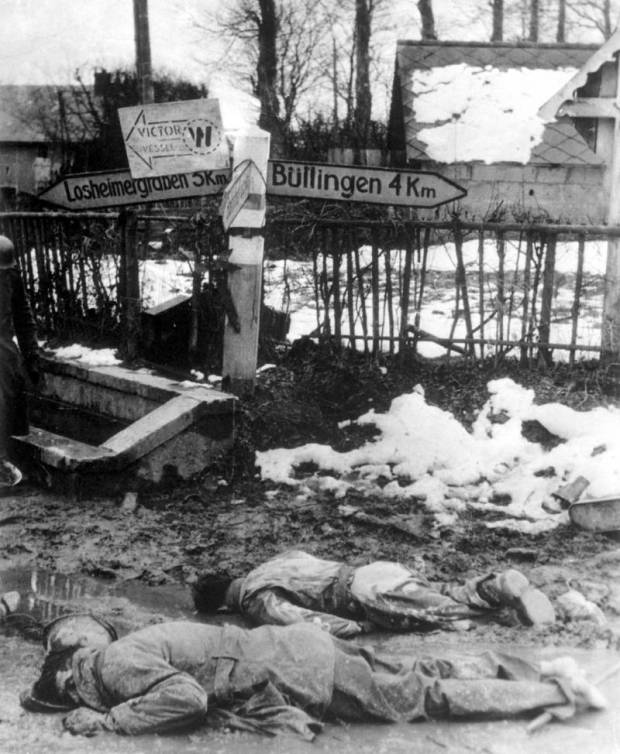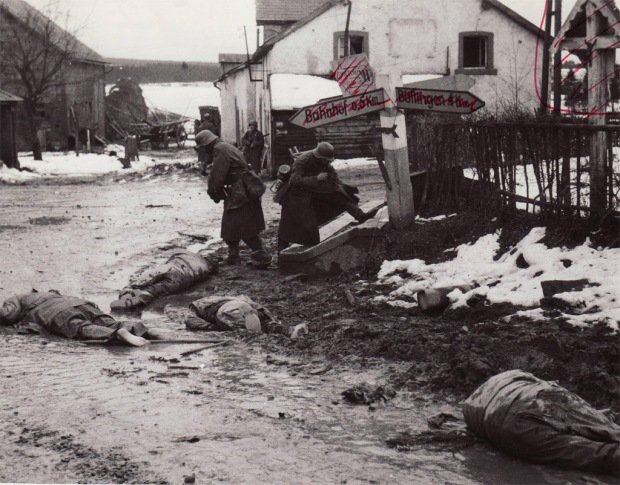
Not all casualties during WWII were caused by battles or other war related events. Like any other era in history there were also other ‘regular’ disasters that occurred. However this disaster was indirectly linked to WWII actions.
October 23 1942 – All 12 passengers and crewmen aboard an American Airlines DC-3 airliner were killed when it is struck by a U.S. Army Air Forces bomber near Palm Springs, California. Among the victims is award-winning composer and songwriter Ralph Rainger.
American Airlines Flight 28 was a scheduled domestic passenger flight that crashed on October 23, 1942 in Chino Canyon, near Palm Springs, California after being struck by a United States Army Air Forces B-34 ‘Lexington’ bomber. The B-34 suffered only minor damage, and landed safely at the Army Airport of the Sixth Ferrying Command, Palm Springs, California.
(the picture below is of a B-34 bomber,not the one that caused the crash)

Flight 28 departed from the Lockheed Air Terminal in Burbank, California at 4:36 p.m. on October 23, 1942.

At 5:02 p.m., Captain Pedley reported his position over Riverside, California, and estimated his arrival over Indio, California, at 5:22 p.m. and 9,000 feet (2,700 m). At 4:26 p.m., the B-34 bomber departed from Long Beach, California, en route to Palm Springs. Lieutenant Wilson proceeded to Riverside, circled twice near March Field, and continued toward the San Gorgonio Pass.
At approximately 5:15 p.m., at an altitude of approximately 9,000 feet (2,700 m), Flight 28 was struck by the B-34. The DC-3 lost its rudder to the propeller from the B-34’s right engine, along with portions of its tail. It fell from the sky in a flat spin and impacted a rocky ledge in Chino Canyon, below San Jacinto Peak, before crashing into the desert and exploding.
Lieutenant Wilson later testified at his court martial proceedings that he first realized that the two aircraft had collided when he heard a “noise and a wrenching of my ship up… to my left.”He also testified that he noticed that his aircraft handled sluggishly and the right engine felt “rough.” He was informed by his copilot that they had hit the airliner. The B-34 called the Palm Springs tower to notify them of the accident and then subsequently landed at Palm Springs Army Airport.
The Burbank operator at the company station reported that he had picked up a message from Flight 28 at exactly 5:15 p.m., saying: “Flight 28 from Burbank… correction Burbank from Flight 28…” The radio operator was only able to distinguish the flight calling Burbank, and though he attempted to respond, he received no answer from Flight 28. He then directed the message to the American Airlines Flight Superintendent at Burbank. The Civil Aeronautics Board determined that, as Flight 28 crashed at 5:15 p.m., it was possible that the pilots were attempting to report the collision
Three separate investigations into the accident occurred: a coroner’s inquest, a military investigation and court martial, and the official Congressional investigation of the Civil Aeronautics Board. All three investigations were independent of the others.

The coroner inquest was the first investigation to be completed, occurring shortly after the crash. Its purpose was not to decide absolute culpability, but rather to determine exactly the manner of death of the involved individuals. During the inquest, both surviving Army pilots testified that they had seen the airliner, but that they had subsequently lost sight of it when their aircraft had flown into smoke from a nearby forest fire.
Air safety investigators of the Civil Aeronautics Board arrived at the scene of the crash at midnight of October 23. The remnants of the aircraft were placed under military guard for the duration of the investigation.During the course of the investigation, it was learned that Lieutenant Wilson of the B-34 and First Officer Reppert of Flight 28 had trained together, and had met up the previous night and talked about their chances of meeting while in flight. Though they briefly discussed the possibility of signalling each other, they made no such plans to the effect. The B-34 copilot, Sergeant Leigh, told investigators that Wilson had confided that he’d like to fly close to the airliner and “thumb his nose at him.”[1] It was for this reason that the bomber circled twice around March Air Force Base in order to ensure that the aircraft would meet up during the flight to Palm Springs.
Subsequent depositions revealed that Lt Wilson flew his B-34 level with the DC-3 and rocked his wings in greeting to First Officer Reppert. When Flight 28 did not respond in kind, the B-34 crossed over the airliner’s line of flight and throttled back to allow the slower DC-3 to catch up. Lt Wilson flew close to the airliner to attempt a second greeting, but misjudged the distance between the aircraft, and when he tried to pull up, the B-34’s right propeller sliced through the airliner’s tail.
The Civil Aeronautics Board determined that the cause of the crash was:
The reckless and irresponsible conduct of Lieutenant William N. Wilson in deliberately maneuvering a bomber in dangerous proximity to an airliner in an unjustifiable attempt to attract the attention of the first officer (copilot) of the latter plane.
— Civil Aeronautics Board Docket #SA-74, File# 2362-42.
Lieutenant Wilson faced manslaughter charges by the U.S. Army. During the course of the court martial proceedings, a number of military witnesses produced testimony that corroborated the findings of the CAB. One witness, however, Private Roy West, provided testimony in direct contradiction of the previous witnesses. According to Private West:
They were coming through this Pass and the Bomber in a right bank and the airliner moved in under it. The airliner nosed down and the tail came up and hit the right motor of the Bomber and the tail was cut off….
— Roy West, Private, US Army, Army Court Martial Proceedings of Lieutenant William Wilson.
The CAB dismissed West’s statement as unreliable, as when a plane’s nose dips, the tail does not rise by such a significant amount as witnessed by West. However, the court-martial trial board acquitted Lt. Wilson of blame in the accident.
The Lockheed B-34 that collided with American Flight 28 was repaired and re-designated as an RB-34A-4 target tug. On August 5, 1943 the same RB-34, serial number 41-38116, suffered engine failure during a ferry flight and crashed into Wolf Hill near Smithfield, Rhode Island, killing all three crew members.
 A U.S. Army RB-34 like the one that crashed on Wolf Hill in the Georgiaville section of Smithfield,
A U.S. Army RB-34 like the one that crashed on Wolf Hill in the Georgiaville section of Smithfield,
I am passionate about my site and I know you all like reading my blogs. I have been doing this at no cost and will continue to do so. All I ask is for a voluntary donation of $2, however if you are not in a position to do so I can fully understand, maybe next time then. Thank you.
To donate click on the credit/debit card icon of the card you will use. If you want to donate more then $2 just add a higher number in the box left from the PayPal link. Many thanks.











































 A U.S. Army RB-34 like the one that crashed on Wolf Hill in the Georgiaville section of Smithfield,
A U.S. Army RB-34 like the one that crashed on Wolf Hill in the Georgiaville section of Smithfield,
You must be logged in to post a comment.